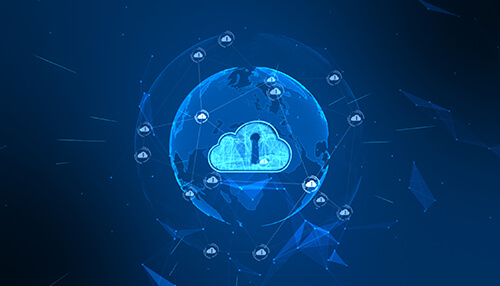52% of businesses identify cloud-based tools and features as an essential factor in their overall infrastructure growth, including physical security trends. Companies are increasingly reliant on cloud-based technologies for infrastructure growth and security.
It is becoming clear that cloud-based technologies are revolutionizing business and security operations for improved efficiency.
Keep reading for a guide to the cloud-based physical security trends for 2022. Consider these technologies concerning the gaps and demands in your current security strategy and whether implementing these features would help you future-proof your security strategy.
Top Cloud-Based Security Trends 2022
Let’s look at the top cloud-based security trends for 2022 that will help you keep your security strategy current and equipped to handle the challenges posed by the modern security landscape.
Access Control
Touchless access control is a cloud-based solution that can help businesses restrict unauthorized entries to their buildings. Using an access control system such as ZTNA is an essential physical deterrent to protecting your business’s on-site data, with touchless access capabilities also providing convenience to your employees. To understand ZTNA, learn more about what is zero trust network access. In schools, law firms, and other businesses that house sensitive information and assets, it is essential to provide clients with the assurance that their data is in good hands.
Employees can use touchless access using mobile credentials, which reduces costs and losses in creating new keys. Users may have a longer induction process with a conventional access system as they wait for your security staff to hand over their keycard.
Pin pad door locks are no longer suitable in a post-pandemic climate, as they increase the number of building touchpoints users must come into contact with as they enter the building, which may lead to contamination. Instead, touchless access control equips you with the tools to reduce touchpoints at the entrance to your facility and promote user well-being.
Mobile credentials can operate door locks via BlueTooth for smoother entry without users having to present their mobile devices directly in front of the reader. Instead, you can detect the device inside a pocket or bag for added convenience. Touchless access control provides better health and safety procedures and added convenience while securing your building from unauthorized access.
Internal Access Control & IoT
Internal access control can create a smarter building and restrict access to areas within the building for a zero-trust approach to building security. A zero-trust security strategy is essential to protect your business from internal misconduct and avoid sensitive data exposure.
With the installation of internal door locks comes the opportunity to use the Internet of Things (IoT) and occupancy management solutions. Occupancy management integrates with internal door locks to accurately picture how often employees use your facilities.
For businesses introducing a hybrid or remote work model, occupancy management offers invaluable information that could inform your decision to downsize your office space. If your occupancy management data reveals that large portions of your office space are unused, this would indicate the potential for downsizing.
You can integrate IoT technology with internal door locks to reduce your monthly overheads by switching off appliances, heating, and lighting in unoccupied rooms. When the door lock is triggered, the room will light up, and the system will switch on appliances. When the room is unoccupied, devices and appliances will be switched off to conserve energy. Not only will this make your building more energy-efficient, but it will also save your business costs on electricity and heating.
Wellness Verification
You can integrate wellness verification software with access control technology to provide health and safety protection for your building and educate your HR team on the mental well-being of your employees.
Since the pandemic, health and safety have become a priority consideration for any security strategy. Upon accessing the building via access control technology, users will fill out survey forms on their mobile devices. You can use these surveys to screen for coronavirus symptoms and protect your space from symptomatic individuals.
Or, you can use these surveys to implement wellness surveys that indicate employee satisfaction and mental well-being. Your HR team can leverage this data to indicate a need for company wellness retreats or wellness seminars. Keeping employees motivated and productive is essential to the overall performance of your business.
Converging Physical and Cybersecurity
With the increased adoption of cloud-based technologies and IoT technologies, there comes an increased need to consider physical and cybersecurity as merged concepts. Since assets are becoming both physical and digital, it is becoming increasingly challenging to approach security with separate departments for physical and cybersecurity.
Housing both teams separately can be detrimental to communications that could help your business respond quickly and effectively to security incidents and security threats.
By merging security and IT teams, you can have a faster response to security threats that fall under the jurisdiction of both teams. This merger can decrease the workload of both teams for a more efficient strategy and may present the opportunity to streamline your team and cut costs.
Using AI Analytics
Security camera systems are a staple feature in any physical security strategy. Not only can they help to provide evidence when a crime occurs, but they can also act as a deterrent for crime. However, it is difficult for security personnel to monitor security camera feeds constantly, so security cameras are rarely helpful in preventing a crime on your property.
AI analytics can help your security team identify potential security threats without religiously monitoring the video camera feed. AI analytics can trigger alerts for security events that allow your security staff to respond quickly and potentially prevent the occurrence of a crime. With this innovative technology, your security staff will have more time to focus on critical tasks, and you will optimize the functionality of your security cameras.
Summary
Cloud-based security tools can help your business provide a security strategy that is competent to face the challenges posed by a modern security climate. By merging physical and digital security tools and teams, you can create a future-proof and efficient security strategy. You can leverage data from wellness verification and occupancy management software to improve your business intelligence and make the most out of your physical security installations.



